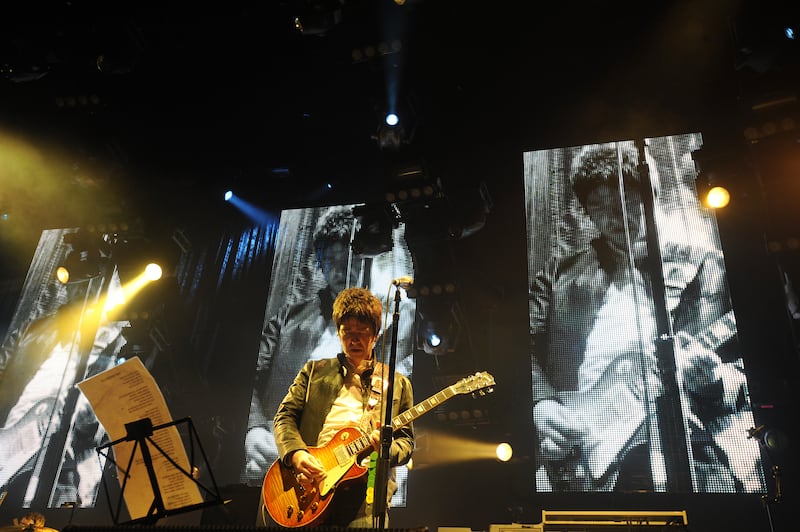Maybe the Oasis reunion was inevitable. Even the worst fraternal dispute couldn’t prevent the coolest band in the world from getting back together, probably selling out all 14 shows (culminating in two nights at Croke Park, Dublin), and reminding the world that they didn’t need to produce a perfect record to be the perfect standard bearers for 90s rock’n’roll. The 1975 frontman Matty Healy got it right last year when he said that “not one person” at a Liam Gallagher or Noel Gallagher solo performance “would not rather be at an Oasis show.”
Now that it has happened – sorry to Blur whose vaunted 2023 reunion will now be consigned to a footnote in musical history – months will be dedicated to dissecting the songs, the nature of the brothers’ success, and their providence. Noel’s commitment in particular to the band’s Irish heritage will loom large, not least thanks to their closing nights in Dublin. “Oasis could never have existed, been as big, been as important, been as flawed, been as loved and loathed, if we weren’t all predominantly Irish,” he wrote in his memoir Supersonic.
This might be overstating the case. But, England saw a tranche of Irish emigrants arrive in the 1960s – plenty of whom settled in Manchester thanks to a booming construction industry and the availability of low-skilled labour. The Gallaghers (born in Manchester to a mother from Mayo) emerged from this tradition: a profusion of the semirural and sectarian Irish sensibilities of their parents and the working class subcultures of Mancunian social housing estates. The trappings were undeniably English: parkas, thick northern accents, Strongbow dark fruits and Umbro (as identified in the New Statesman as key components of the Oasis aesthetic).

So Oasis aren’t Celtic (in spite of Noel’s protestations to the contrary) but another product of Anglo-Ireland’s long running creative conversation. Shane MacGowan of The Pogues and Johnny Marr of the Smiths too. England has long been a welcome host and generous adoptive-home of the Irish emigrant and this is reflected entirely in the cultural production of both countries (distinct from one another but in constant exchange). And this process is far from abating. In the 12 months up to April 2024, 15,200 people left the Republic to live in the United Kingdom (up about 600 from the year before). And it works in the other direction too (in fact, the trend for more Irish ending up in England has somewhat reversed): 20,500 people moved from the United Kingdom to the Republic in the same time period.
READ MORE
A distinct London-Irish identity has fomented around this back-and-forth – reflected literally in the London-Irish centres in Camden and Hammersmith; the pockets of Irish communities in Hackney, Clapham and Kilburn; the blended accent; the Irish restaurant Cafe Cecilia along one of London’s northeast canals; the children of one English and one Irish parent. The factors that pushed Ireland into being a nation of mass emigration – one now with a nearly boundless diaspora – are varied and have very often been tragic. The result, now, is a nation (however regrettable the push-factor) better off for it.
Take, for example, the towering figures of our literary realm. WB Yeats wrote of Innisfree’s “purple glow” and “low sounds” from Chiswick in west London; Edna O’Brien satirised Ireland’s Catholic establishment from the same city; JM Synge and Seán O’Casey both wrote from there too. It is encoded in Irish literary DNA to write about the country at some distance from it. When we think of Ireland’s cultural output we are more often than not thinking about the Anglo-Irish relationship the irony of sharp-edged nationalists using these names as proof of Ireland’s cultural superiority should not be lost on us).
And it is not just England. James Joyce forged Leopold and Molly Bloom in Trieste; he conceived of The Dead – the closing story in Dubliners – in Rome; he wrote most of Finnegans Wake in Paris. Samuel Beckett’s most celebrated (and rather miserable) plays were written in the same city: Endgame, Krapp’s Last Tape. Waiting For Godot was originally written in French (En Attendant Godot). Ireland’s creative universe is completely international – the country’s first exercises in globalisation long before it ever got a taste of the European Economic Community.
A nation whose story has long been defined by mass emigration was bound for this kind of cultural cosmopolitanism. And it is a welcome rebuke to priggish tales of Ireland’s parochialism and diminutive size. Though the comparison to the literary greats seem rather lofty, Oasis were a product of the Irish diaspora just as plenty of our defining poems were. And none of these so-called Celtic greats ever got there by looking inward.















